
Architectural shingles cost is determined by project size, material quality, and roof condition. Find out how much they'll cost for your home.
The sky’s the limit, literally, with these options


To find out what material or upgrade is best for your roof, contact a local roofing pro who has experience working with your climate-specific needs.
Slate, clay, and copper roofing materials are some of the heaviest and not suitable for every roof.
Metal and synthetic shingles last longer than typical asphalt ones.
The type of roofing material that works best for your home depends on the local climate, aesthetic preferences, and budget. Although asphalt is the most popular material used in roofing (in the form of shingles), you have many materials to choose from—and the list is constantly expanding. This guide breaks down the pros and cons of 13 popular roofing materials so you can decide which choice makes sense for your home.
| Roofing Material | Life Span | Cost (per sq. ft.) |
|---|---|---|
| Asphalt | 10–20 years | $1–$1.20 |
| Metal Shingles and Shakes | 50–75 years | $6–$16 |
| Metal Standing Seam | 50–75 years | $10–$16 |
| Wood Shingles or Shakes | 30–50 years | $6–$15 |
| Slate | 125–200 years | $10–$30 |
| Synthetic | 25–50 years | $5–$12 |
| Clay Tiles | 50–100 years | $10–$20 |
| Concrete | 50–100 years | $10–$20 |
| Rolled Roofing | 5–8 years | $2–$5.50 |
| Built-Up Roofing | 20–30 years | $2.50–$5 |
| Roofing Membrane | 20–35 years | $4–$8 |
| Green Roofing | 40–50 years | $10–$30 |
| Copper Roofing | 70–100 years | $15–$35 |
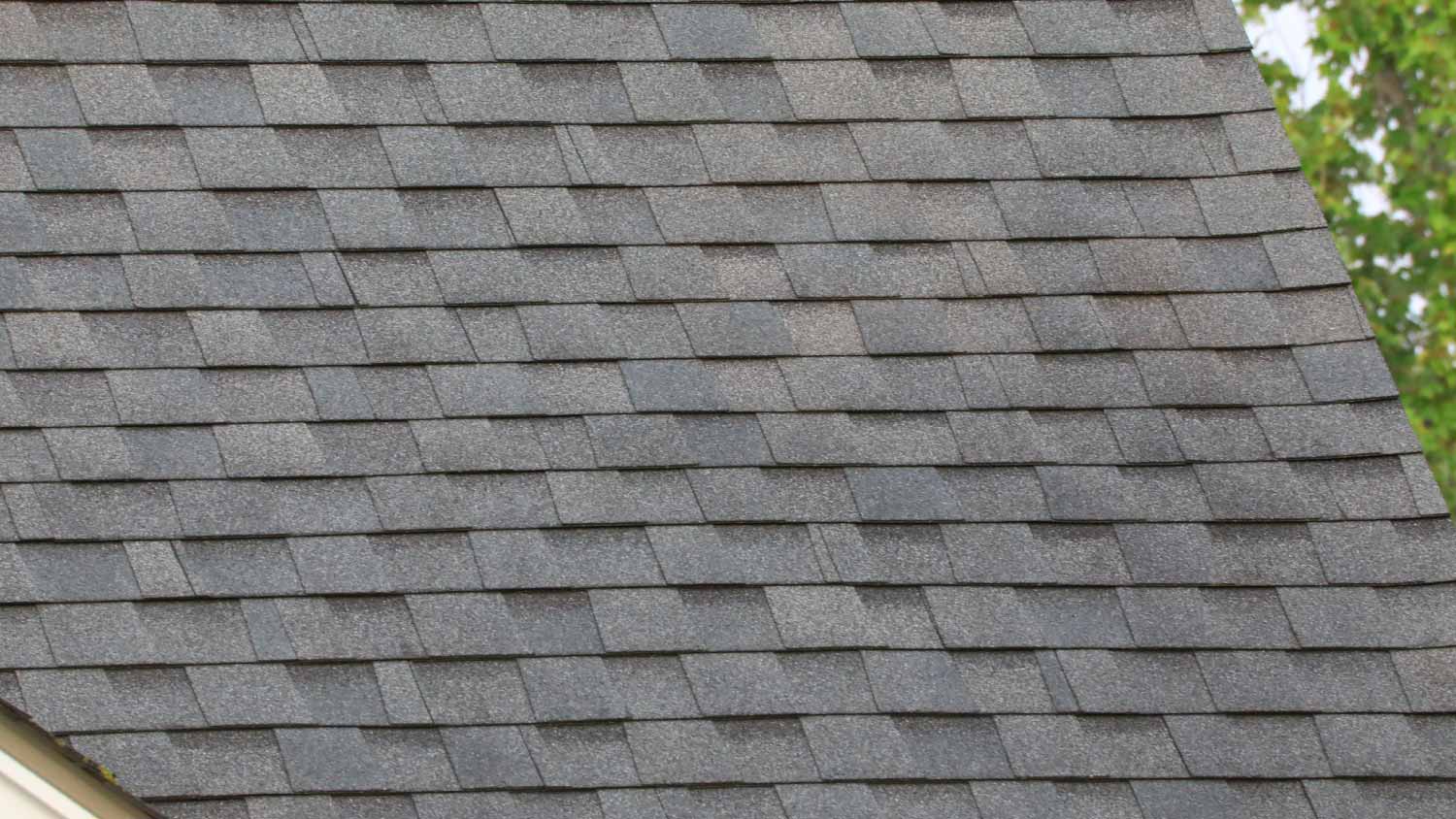
Asphalt shingles are the most popular roofing material and are used by the majority of homeowners across the country. Asphalt is a composite material made from mineral aggregates and bitumen that comes in a thicker multi-layer version or a thinner three-tab version. Asphalt roofing is popular because it is an incredibly sturdy roofing material for all climates, and asphalt shingle costs are budget-friendly compared to other roofing types.
Asphalt shingles are the most popular roofing option on the market due to the value you get for your money. Individual shingles are easily replaced as the roof ages or suffers storm damage. Keep in mind that homeowners can also choose between asphalt and fiberglass shingles, though fiberglass does not typically hold up as long in comparison.
| Pros | Cons |
|---|---|
| Highly durable | Shorter life span |
| Lower cost | Quality variations |
| Customizable |
Best for:
Budget-friendly roofing
Homes in the northeast
Roofs with complex shapes
To achieve the look of clay tiles, cedar shakes, or slate tiles without the maintenance and difficult installation process of traditional materials, you can choose metal shingles and shakes, which are relatively new roofing materials that mimic the look of natural materials. Metal roofs require minimal maintenance, and shingles can be replaced in the event that they are damaged. This long-lasting roofing material does tend to be more expensive than other types of roof shingles, but you will likely save on the cost of maintenance over the life of the roof.
| Pros | Cons |
|---|---|
| Highly durable | Higher cost |
| Customizable by color | Can be heavy |
| Low maintenance | Tricky to install |
| Eco-friendly |
Best for:
Alternative to clay tiles
Fire-prone regions
High-wind regions
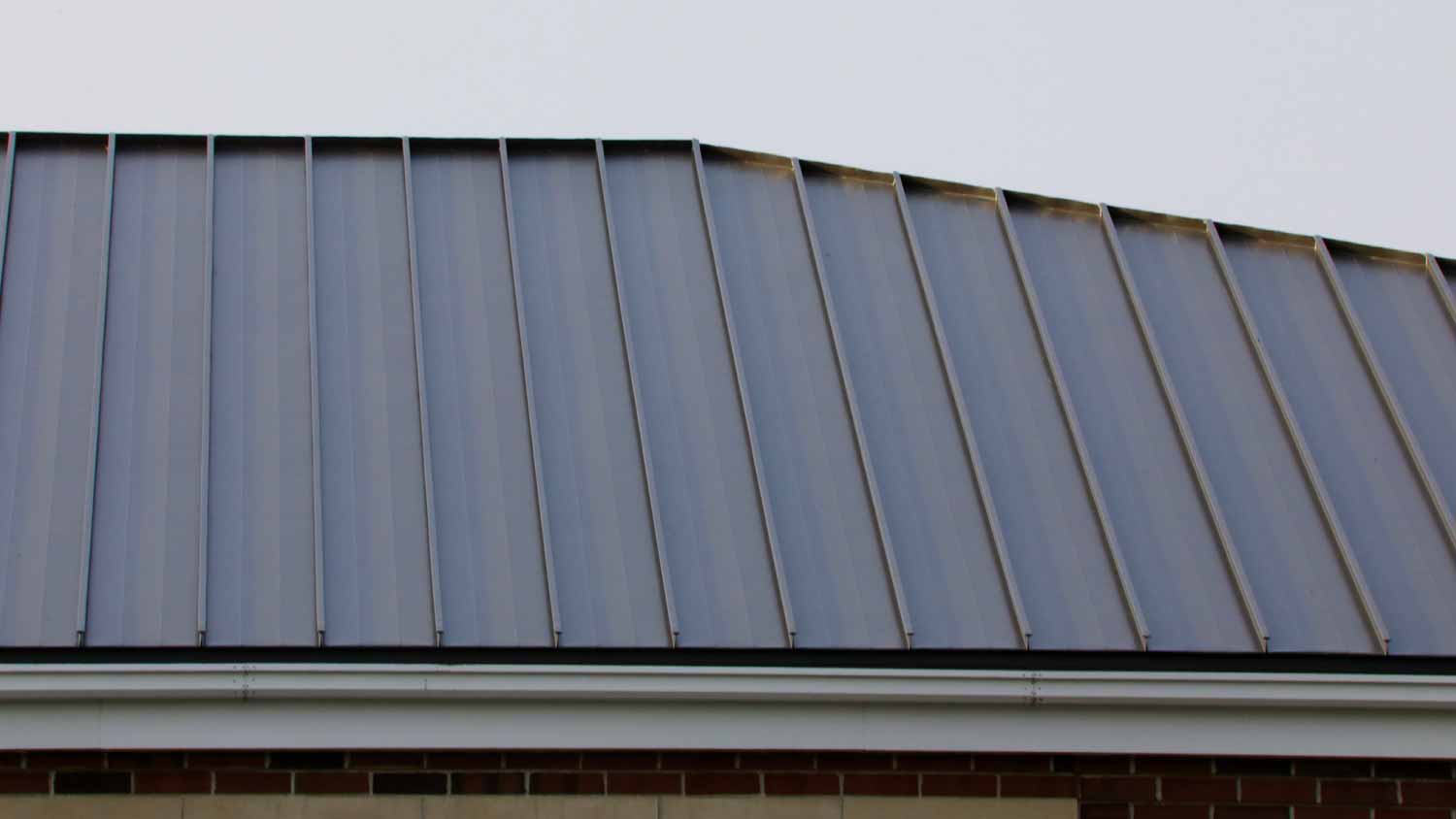
A standing seam metal roof offers a streamlined and minimal look. The metal roof panels have raised ridges that overlap one another at the seams and hide the fasteners. This can help reduce the likelihood of corrosion and wear at the fastener sites. Standing seam metal roof installation is more difficult than screw-down metal roof installation, so hiring a professional for this may be the way to go.
| Pros | Cons |
|---|---|
| Highly durable | Higher cost |
| Customizable by color | Can be heavy |
| Low maintenance | Requires pro installation |
| Eco-friendly | |
| Streamlined, minimal look |
Best for:
Low-maintenance design
Modern home styles
Thanks to modern technology, wood is now a feasible, long-lasting roofing material. Wood shingles or shakes offer a rustic, Craftsman-like style and often look better with age. Certain wood roofing products are made to be environmentally friendly from sustainable sources and are even biodegradable. You're more likely to find wood shingles and shakes on historic home designs such as mansard roofs or Victorian homes with multiple ridges.
The downside is that wood shingles can be costly to install and repair. They can also be difficult to work with, making the installation costs higher. Wood shingles are not recommended if you live in an area with extreme weather. Additionally, the material is highly flammable and prone to insect damage and rot.
| Pros | Cons |
|---|---|
| Timeless roof style | Higher cost |
| Eco-friendly | Low durability |
| Highly customizable | Not ideal for all climates |
Best for:
Cabins and Craftsman homes
Homes not prone to wildfires
Historical home styles
Offers a classic look
Environmentally friendly natural product
Expensive to install
Not as durable against the elements
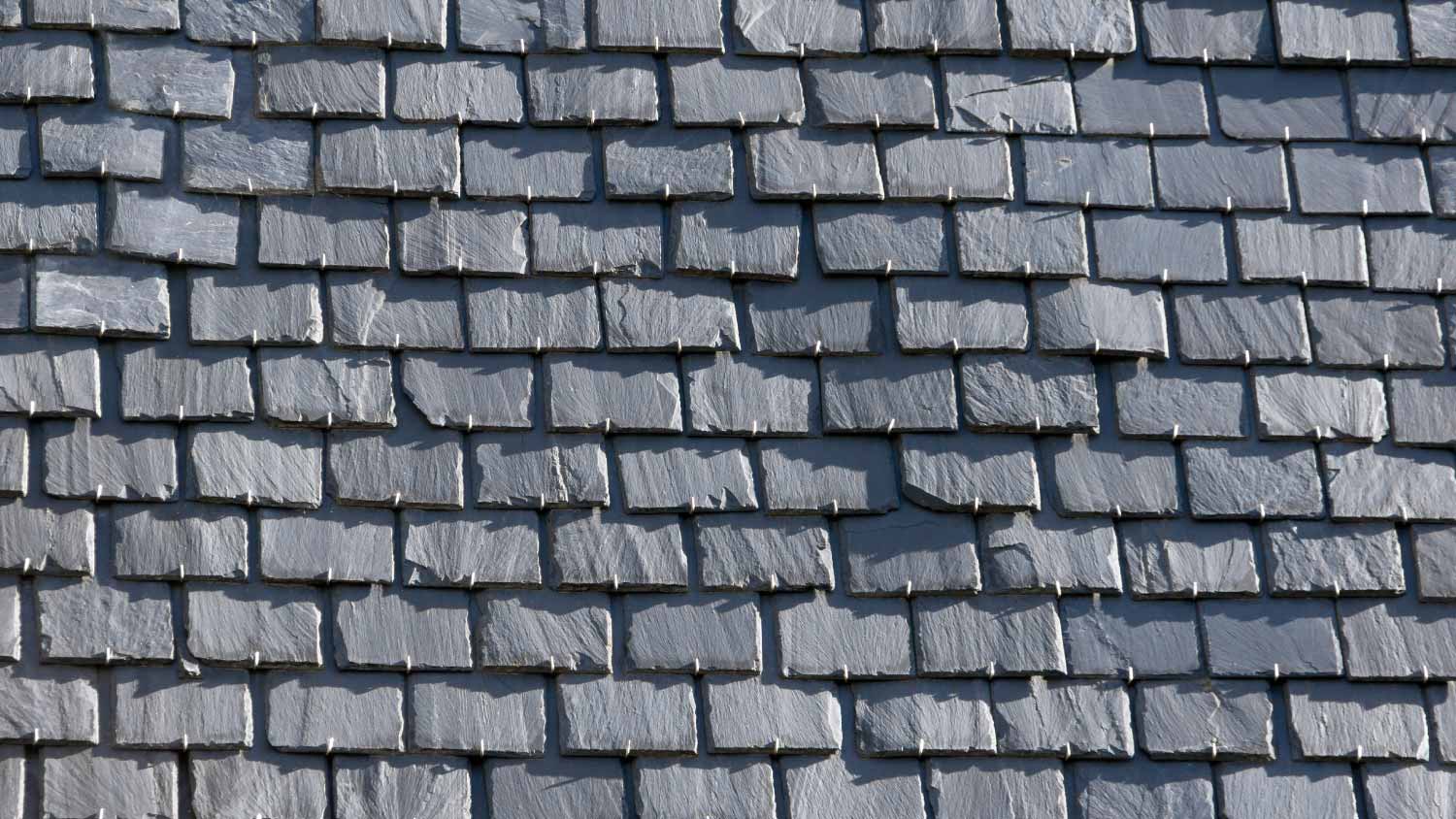
Slate is a beautiful roofing material option, often available in shades of black, green, gray, and red. It is good for warm climates as it protects from the heat. This type of roofing is heavy duty and lasts for a long time. Since slate is made from stone, it is not as easily damaged by the elements, although the shingles can still crack.
If your home does not already have a slate roof, it might be difficult to replace your current roof with this material. Slate is extremely heavy, so the roofing structure must be strong enough to support it, which can add to the cost of a slate roof. Consult a local roofer to determine if your home can support it.
| Pros | Cons |
|---|---|
| Highly durable | Higher cost |
| Unique style | Very heavy |
| Enhances curb appeal | Difficult to install and repair |
Best for:
Classic-style homes
Homes with strong roofs
Fire-prone areas
Synthetic roofs, made from plastic, rubber, or polymers, are rising in popularity. The products are made to mimic the look of traditional roofing materials, like slate or wood shingles while offering superior durability due to the engineered makeup. Some synthetic roofing products are even fire-resistant. And while the cost of a rubber roof and similar synthetic materials is higher than other popular options, its high durability pays for itself in the long run.
Speak with a specialist about this category of roofing before proceeding with an installation. It is still relatively new to the market, so some installers are not as familiar and experienced with it. If you do choose a quality product with an experienced installer, synthetic roofs look like the real deal and last longer.
Try not to confuse synthetic roofs with the popular synthetic underlayment. An underlayment is the water-resistant layer between the roof rafters and roofing material. While there are some problems with synthetic underlayment overall, it is a popular choice in areas highly susceptible to moisture and extreme temperatures.
| Pros | Cons |
|---|---|
| Highly durable | Quality variation |
| Highly customizable | Requires a specific contractor |
| Lightweight |
Best for:
Budget-friendly roofs
Storm-prone regions
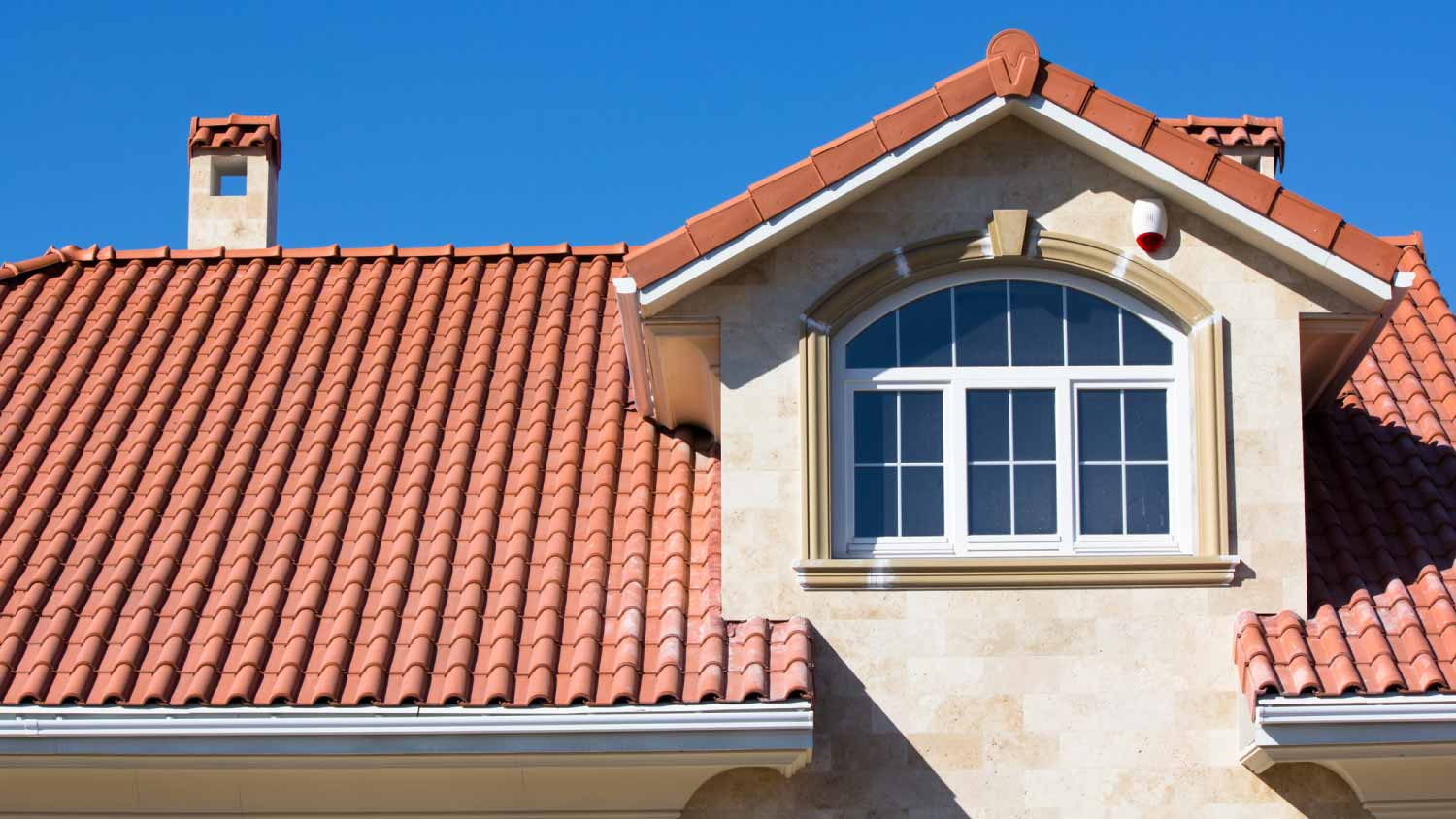
Clay tiles are sometimes referred to as “barrel tiles” for their signature rounded shape or as “Spanish tiles” for their origins in Mediterranean architecture. Because they are made of dried clay, they are very heavy, so installing them on a roof may require adding structural support to hold their weight. They often last 50 years, but some have been known to last over 100 years with proper maintenance.
In regards to maintenance, any cracked or broken clay tiles should be repaired or replaced. These repairs can be costly and should be done by a trained roofing professional who specializes in clay tiles. Because of these factors, tile roof costs can be higher than other materials.
| Pros | Cons |
|---|---|
| Highly durable | Higher cost |
| Classic look | Requires a specific contractor |
| Enhances curb appeal | Very heavy |
Best for:
Southwest-style homes
High-wind regions
Concrete tiles are highly durable and long-lasting, but they are also incredibly heavy. They can mimic the look of natural materials, like slate and wood, as well as asphalt shingles. While slate and wood roofing tiles can be very costly, concrete tiles offer a more affordable roofing material alternative.
Because of their weight, they may require structural reinforcement before installation, but they are also so strong that you'll enjoy the perks of an impact-resistant roof. Concrete tiles should be sealed periodically to help prevent water absorption, which can lead to cracking.
| Pros | Cons |
|---|---|
| Long-lasting | Very heavy |
| Highly durable | Comparatively high maintenance |
| Comparatively affordable |
Best for:
Regions with fires and storms
Strong roofs
Budget-friendly clay alternative
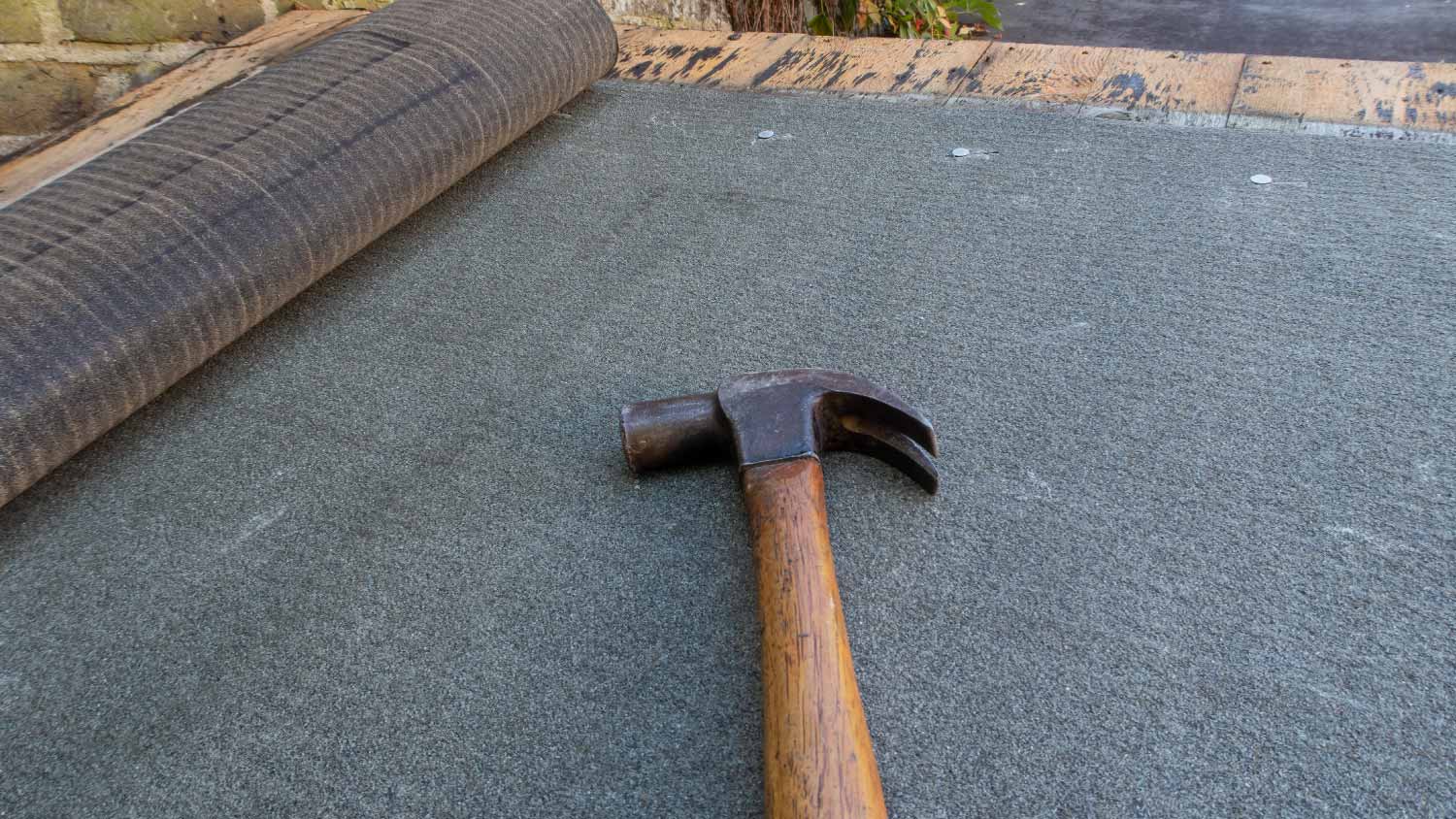
Often used on low-slope or flat roofs, rolled roofing is easy to install because it comes in rolls that can be unrolled on the roof and nailed into place. It can also be referred to as mineral-surfaced, or MSR, roofing. While this material is not typically used for homes, it can be a good option for outbuildings like a shed or garage.
This type of roofing material is prone to damage because, as one large sheet, it does not expand and contract as well as individual shingles, which can lead to tears. It also tends to lose its grains and does not increase the resale value of the home.
| Pros | Cons |
|---|---|
| Very affordable | Low durability |
| Easy to install | Short life span |
| Low ROI |
Best for:
Flat roofs
Garage and shed roofs
Built-up roofing, or BUR, is among the roof material types that are ideal for use on flat or low-pitch roofs. It uses several layers of materials that are built up on each other to form the roof. Roofing felt is impregnated with asphalt and applied hot in overlapping layers. After two to four layers have been applied, it is covered with hot tar and finely crushed stone.
As this type of roofing is used for flat roofs, you may not have noticed it, but the next time you are on an upper floor in a school or hospital, you may be able to look down at lower roof sections and catch a glimpse of it.
| Pros | Cons |
|---|---|
| Durable and long-lasting | Rarely used on homes |
| Ideal for flat or low-pitch roofs | Not a DIY project |
Best for:
Flat roofs
Commercial buildings
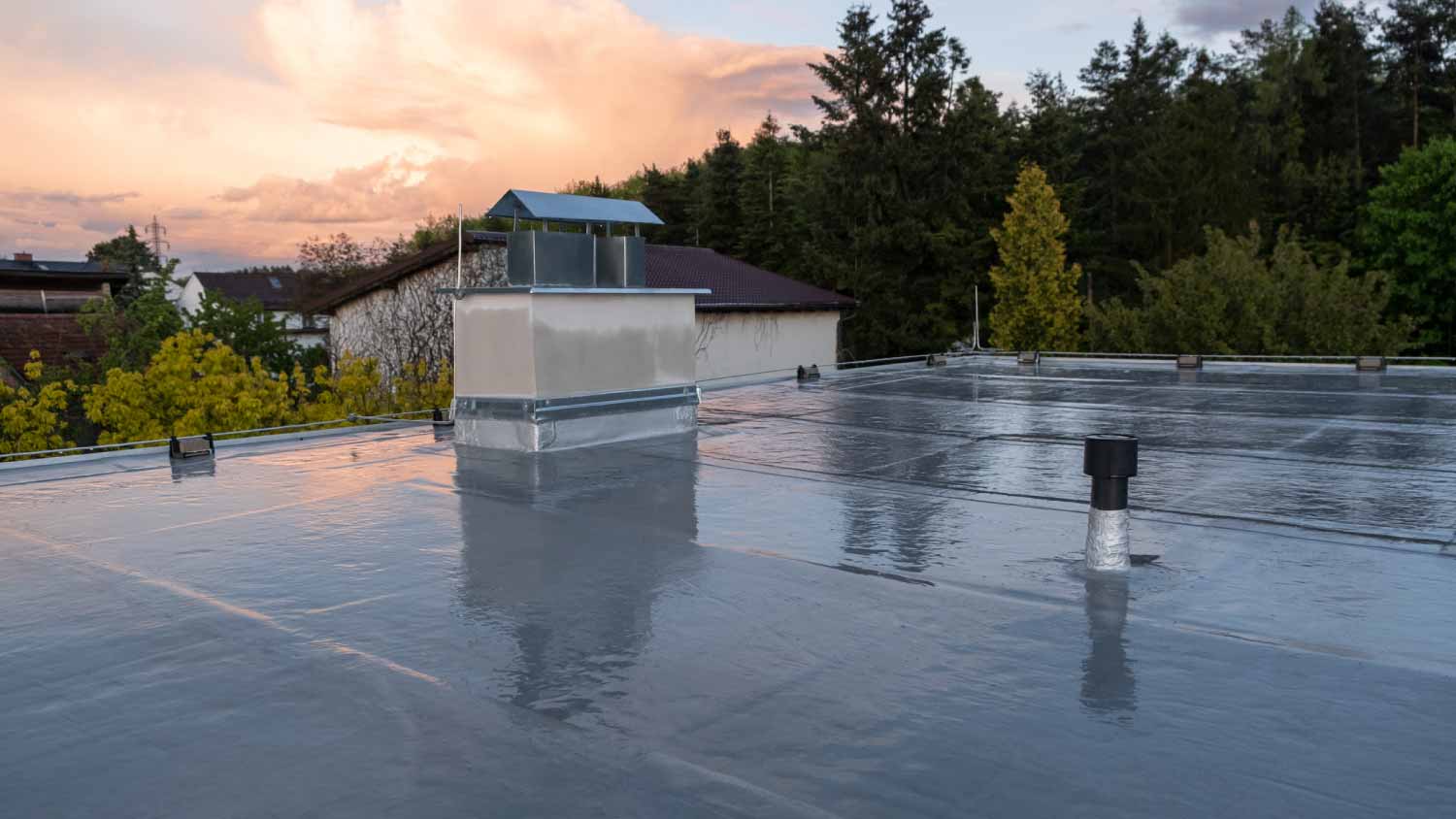
Also for use on flat or low-pitch roofs, roofing membrane can last between 20 and 35 years. There are several types of roofing membrane to choose from: neoprene, EPDM (ethylene propylene diene monomer), PVC (polyvinyl chloride), chlorinated polyethylene and chlorosulfonated polyethylene sheets, TPO (thermoplastic polyolefin), and polymer-modified bitumens. Choosing between EPDM, PVC, or TPO roofing often comes down to price and the level of durability needed in your area.
These terms may not mean much to the average homeowner, so if you choose roofing membrane for a garage or shed, be sure to talk with a roofer near you to discuss options. This material is often black, which can absorb heat and is one of the reasons why it is not recommended over living spaces, but it’s also available in white. It is not recommended for residential applications unless used on an outbuilding or garage.
| Pros | Cons |
|---|---|
| Durable and long-lasting | Rarely used on homes |
| Ideal for flat or low-pitch roofs | Easily punctured and leak-prone |
Best for:
Sheds and garages
Uninhabited buildings with flat roofs
Green roofing, also called “living roofs,” is a great way to remove pollutants from the air, absorb rainwater, provide a natural habitat, and create thermal insulation. Green roofs begin with a waterproof membrane on which dirt and plants are then added. One of the most unique roofing options, a green roof offers a way to care for the earth and add an unexpected touch to your home. This type of roof will require active maintenance to achieve your individual goals and keep plants in check.
| Pros | Cons |
|---|---|
| Eco-friendly and sustainable | Heavy and may require support |
| Attracts wildlife | Requires ongoing maintenance |
| Provides thermal insulation |
Best for:
Roofs with direct sunlight
Eco-conscious homes
Flat or low-slope roofs
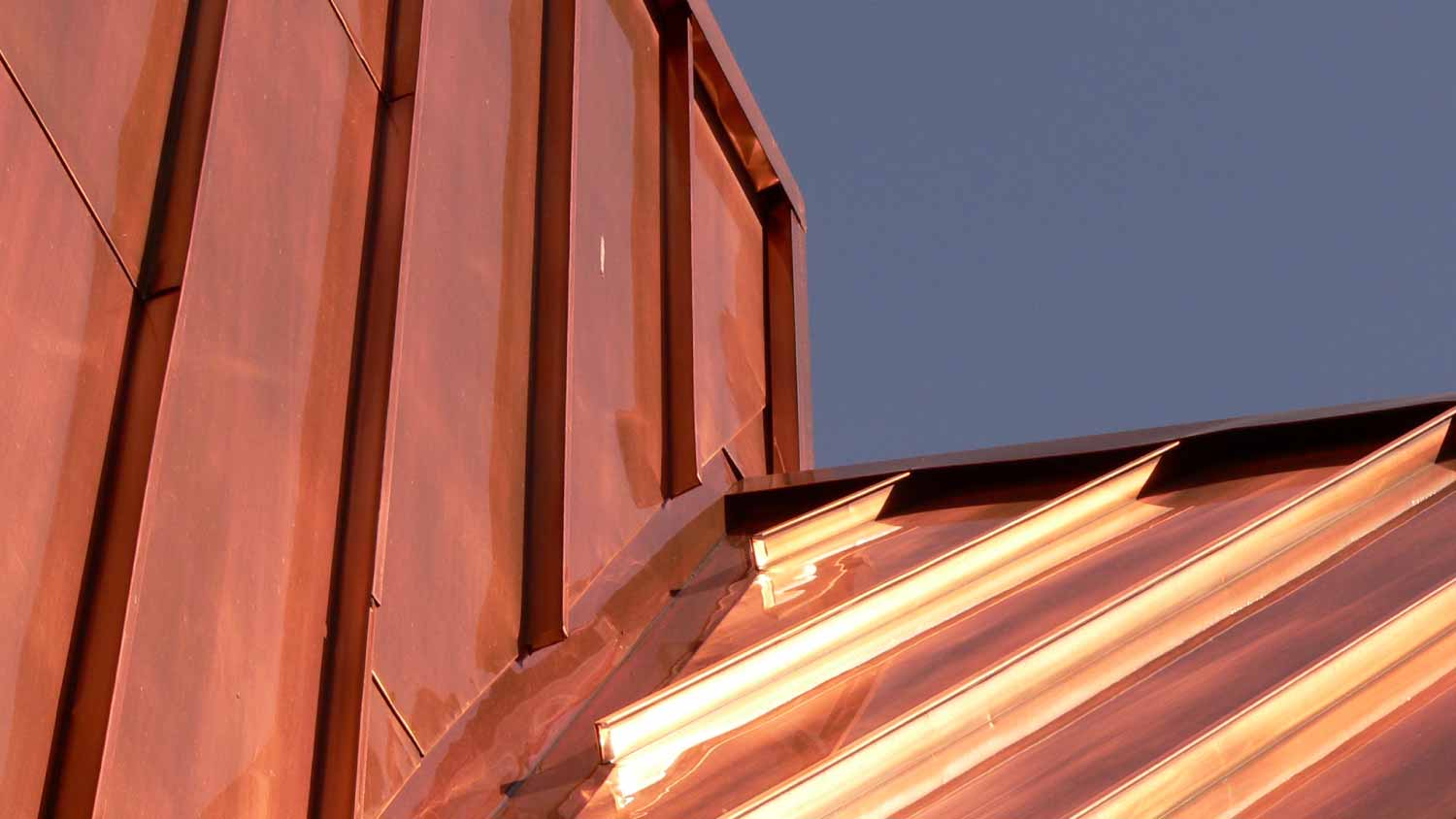
You can achieve a classic look with the highly durable copper roofing. While you will pay more for the cost of a copper roof, it can last up to 100 years and requires minimal maintenance. Copper roofs are also fire-resistant, a great insulator, and easy to maintain.
You should regularly clean a copper roof to protect it from possible acid rain corrosion, but it is otherwise quite durable. Over time, copper roofing even adapts to develop a new delicate patina, a perk highly appealing to its long-term curb appeal.
| Pros | Cons |
|---|---|
| Highly durable | More expensive |
| High ROI and resale value | Difficult to install |
| Eco-friendly and sustainable | Can be noisy |
Best for:
Modern-style homes
Sheds and garages
Fire-prone areas
Selecting a new roof means taking many different factors into consideration. In addition to the different types of roofing materials, you will have to take into account the roof replacement cost, your local climate, energy efficiency, and installation methods.
When choosing materials for a new roof, consider the ongoing maintenance and repair costs associated with them. You’ll spend more over the life of the roof to repair materials like slate or wood shingles, whereas asphalt is the most budget-friendly option.
The most commonly sought-after asphalt shingle roof repair involves fixing water leaks. Homeowners also want recommendations from a roofer for repairs that prevent damage and keep their roofs in good condition. Other common issues include broken, missing, cracked, and loose shingles, water stains, and other related problems.
The many factors that play into choosing a roofing material may surprise you, such as durability, cost, style, and the climate in which you live. Many homeowners choose asphalt, but there are various types on the market. A roofer can advise you on the best materials for your home and region.
Climate considerations include the local temperature range, average rainfall, average wind speeds, and potential for snow and ice. Whatever you choose for roofing in cold climates should be able to shed snow and water without forming ice dams or creating leaks. Hot-weather roofs should reflect rather than absorb light. If wind is a concern, the roofing material should be able to withstand wind uplift as much as possible.
Energy-efficient roofs like metal roofs, asphalt shingles, concrete tiles, and wood shingles, among other types of roofing, can help reduce heating and cooling costs, saving you money on your energy bills and being a little more kind to planet Earth.
Some roofing materials, like metal roofing and asphalt shingles, are better suited to DIY installation. If you want to do the job yourself, it is important to choose a roofing material that you are comfortable with, and that is suitable for you to install yourself or with a friend or two.
From average costs to expert advice, get all the answers you need to get your job done.

Architectural shingles cost is determined by project size, material quality, and roof condition. Find out how much they'll cost for your home.

If your metal roof needs a repair, it’s best to hire a roofing professional to handle it safely. Stay tuned to learn about cost factors for metal roof repair.
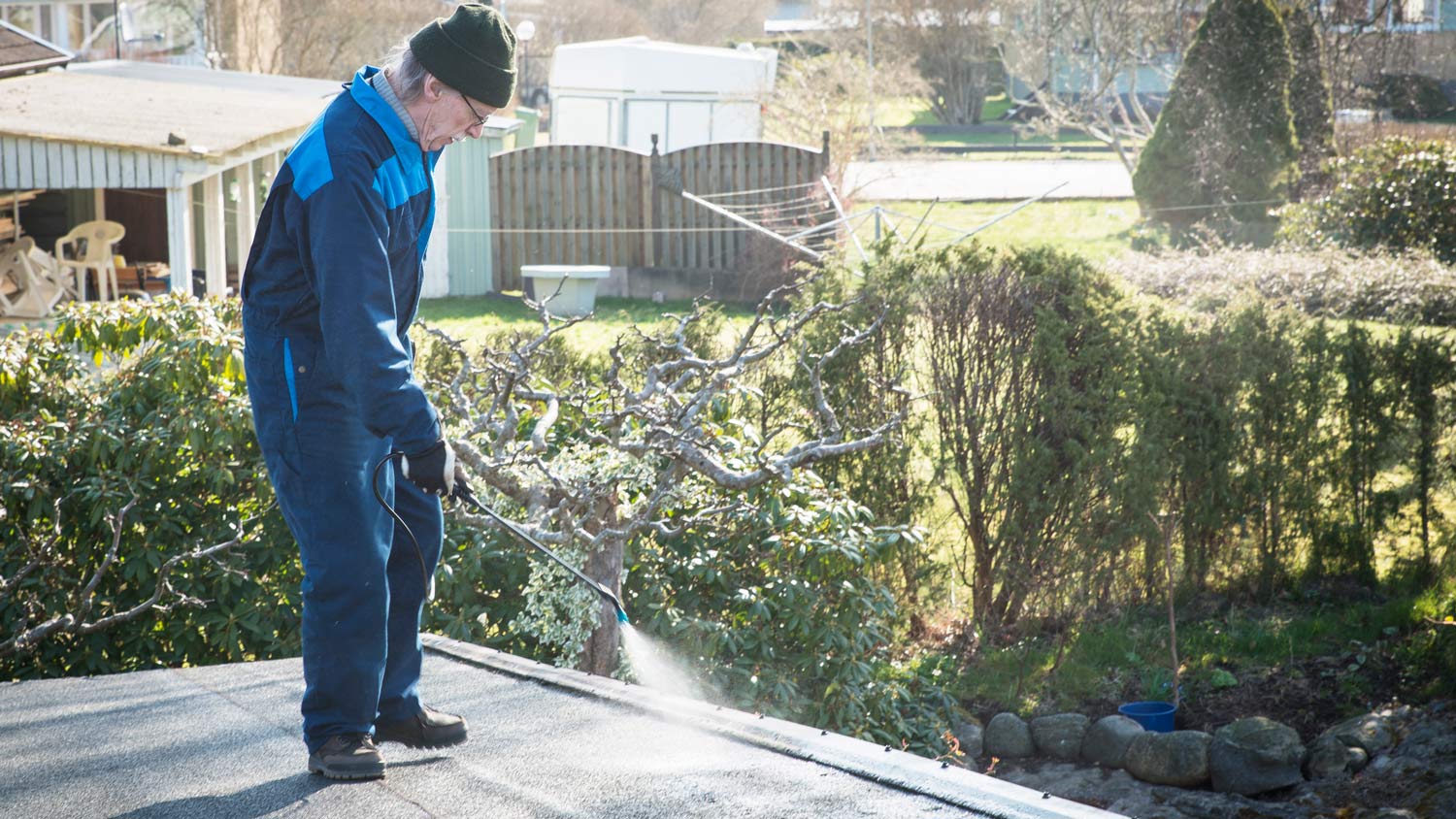
Spray foam roofing is a budget-friendly option to protect your home from energy loss and water damage. Learn how much spray foam roofing costs.

While there are various styles, the right roof drip edge type for your home will depend on your roof type and the rainfall in your climate.

Shingles that are losing their granules may not be protecting your roof. Learn why shingle granule loss happens and what it means for your roof.

Discover how to install metal roofing over shingles to add long-lasting weather protection to your existing roof without removing the old material.